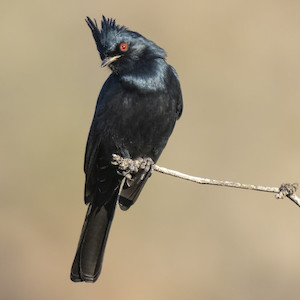“Who’s that singing?” asks Skyler Mark on a still chilly morning in Mesa Verde National Park. Against a backdrop of Western Meadowlarks, Spotted Towhees and two insistent Northern Mockingbirds, the melodious whistles are almost drowned out. “Sounds like an oriole,” she remarks before spotting the bird near the top of a nearby juniper, “Oh cool! It’s a female singing! I’ve never seen that before.” Mark is surveying birds for a new project IBP’s is launching in partnership with the National Park Service - Avian Population Monitoring in Southwest National Parks.

A female Scott's Oriole. Photo by Mick Thompson/Flickr.
This spring IBP began implementing the bird monitoring component of the National Park Service’s (NPS) Inventory and Monitoring Program for selected parks within the Southern Colorado Plateau Network (SCPN). The Inventory and Monitoring Program helps the NPS understand “the range of natural resources in and around parks” and “how these resources are doing over the long term.” We are implementing long-term bird monitoring programs in 6 parks in the SCPN: Canyon de Chelly National Monument, Grand Canyon National Park, Petrified Forest National Park, Wupatki National Monument, Mesa Verde National Park and Bandelier National Monument. Surveys involve point counts, in which a trained observer counts birds heard and seen during a set time period at set locations along transects distributed across the parks.

Crew member Skyler Mark conducting a point count in Mesa Verde National Park.
IBP has been doing this type of work with the NPS since the Inventory and Monitoring Program began in Yosemite in 1998. We continue to monitor birds in Yosemite and other parks of the Sierra Nevada Network, and have also been working in 5 parks of the North Coast and Cascades Network since 2005. In the SCPN, we are using the same surveying methods that we are using in the two other monitoring networks. “Though these monitoring networks are very different, this standardization will allow for some interesting comparisons between bird population trends in the three regions,” says Dr. Harry Jones, IBP’s Southwest Avian Ecologist who is leading this project. Jones is also working on an analysis and report on the last 10 years of bird monitoring data collected by the NPS.
New Region, New challenges.
A new region means different birds, habitats, terrain, and climate. The Southern Colorado Plateau poses some new, as well as some familiar, challenges. First off, the parks in this region have diverse habitats. For instance, the North Rim of the Grand Canyon sits above 8,000 ft in elevation and is primarily mixed conifer forest, while Petrified Forest NP is generally below 6000 ft and features substantial native shortgrass prairie and dwarf shrublands. These habitat differences not only affect what species of birds are present, but also how many species can coexist in a habitat, and how easily they are detected.
Another big difference in the southwest is phenology, or the timing of natural events like breeding. Spring comes much earlier in the southwest than in the Sierra Nevada and Cascades, so birds breed earlier there. Because bird surveyors detect most birds by ear, it’s important to conduct surveys early in the breeding season, when breeding birds are singing most frequently. Surveys in the SCPN began April 28th this year and will end by June 28th, while surveys in the North Coast and Cascades Network parks did not begin until the end of May.

A Phainopepla. Photo by Mick Thompson/Flickr
The southwest’s summer monsoon season adds another phenological wrinkle. This period of thunderstorms and brief, intense rains begins in about mid-June to early July and leads to a flush of insects and vegetation as well as a resurgence of breeding for some bird species. But the timing and intensity of the monsoon season is getting harder to predict as climate change is making the monsoon’s storms more extreme and unpredictable.
In addition, the survey schedule must account for migration. Many bird species pass through the southwest on their way to breeding areas farther north or at higher elevations. For instance, the monitoring crew saw Virginia's Warbler, Gray Vireo, and Cassin's Kingbird, birds more typical of forest and woodland habitats, at Petrified Forest National Park. “These are great birds, but they are just stopping over,” says Jones. He notes that surveys are timed to try to avoid the flush of migrants passing through and focus on species that actually breed in the parks.
One familiar challenge in the southwest is fires. Wildfires can be a significant logistical challenge for fieldwork in the Sierra (and increasingly the Pacific Northwest) and they have affected survey schedules this year in the southwest as well. Surveys planned for late April at Wupatki National Monument had to be delayed because the crew could not access the park due to the Tunnel fire. Similarly, Bandelier National Monument was closed for almost the entire month of May due to the Cerro Pelado Fire.
This year’s surveying is wrapping up soon and SCPN Program Manager Dr. Matthew Johnson is enthusiastic about the project. “It is an exciting time in avian ecology for SCPN. The Park Service made a substantial investment to sample birds and their habitats in six parks over the last decade and we are eager to put those data to use,” he says. “Aside from using IBP’s forthcoming results to identify bird habitat restoration options within network parks, we also are looking forward to broadening our data’s utility by incorporating protocol modifications identified during collaborative review of the network’s bird monitoring methods.”

A Cassin's Kingbird. Photo by Wendy Miller/Flickr






